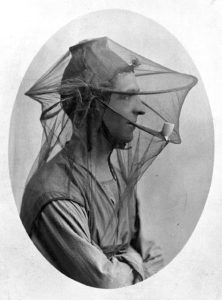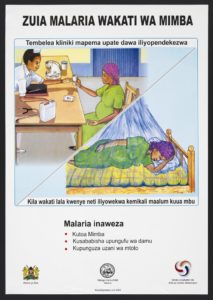Mosquitoes have been linked with illness for thousands of years. Mosquito nets became popular around the world after 1897, when it was proven that a parasite spread by mosquitoes causes malaria. Colonial governments in West Africa were slow to adopt strategies for controlling mosquitoes, such as nets, window screens, and insecticide. Promoting the racist notion that the native population harbored the malaria parasite, many colonists lived in segregated settlements, and they provided window screens only for select European facilities.
Although malaria has been eradicated in North America and Europe, more than half the world’s population remains at risk today.
Content from the exhibition Design and Healing: Creative Responses to Epidemics, curated by MASS Design Group and Cooper Hewitt, Smithsonian Design Museum
+++++++++++++++++++++++++++++++++++++++++++++
Mosquito Net Veil
Nets can be sewn onto wearable armatures. The netting should not touch the skin because mosquitoes can land on the netting and bite through the small openings.

Postcard: Mosquito net to be worn as a veil, Wellcome Collection
+++++++++++++++++++++++++++++++++++++++++++++
Contemporary Bed Nets
Nets sprayed with insecticides kill mosquitoes after they land on the net, further limiting the spread of malaria.

Poster: A pregnant woman receiving anti-malaria medication and lying beneath a mosquito net, Kenya Ministry of Health, 2003, Wellcome Collection
+++++++++++++++++++++++++++++++++++++++++++++
Painted Window Screens, 1953
William Oktavec (American, b. Czechoslovakia, 1885–1955) began painting window screens in Baltimore, Maryland in 1913. The painted image is opaque from the street but transparent from inside the home, offering both privacy and ventilation.

Photograph: Jack Engleman Studio, Baltimore Sun, 1953, hand colored by Peggy Fox, 2012, Courtesy of Elaine Eff
+++++++++++++++++++++++++++++++++++++++++++++
Enclosing the Swamp
Mosquitoes breed in still water, including swamps. Dr. Albert Freeman Africanus King (American, 1841–1915) proposed building a screened enclosure over Washington, DC, taller than the Washington Monument.

Photomontage: Jeffrey Mansfield, MASS Design Group